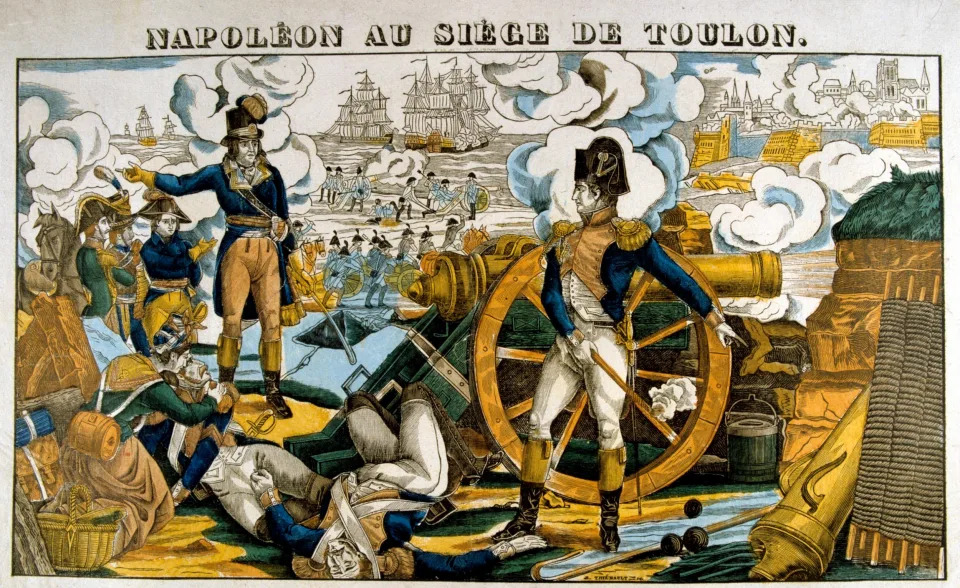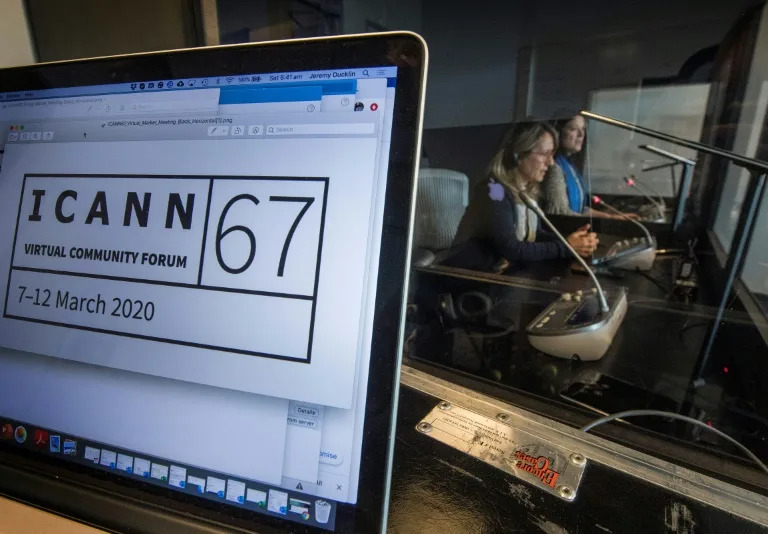British space companies invited to join race to build Europe’s new rocket
Sarah Knapton
Tue, November 21, 2023

ESA director general Josef Aschbacher with German government aerospace coordinator Anna Christmann - JOSE MANUEL VIDAL/EPA-EFE/SHUTTERSTOCK
The European Space Agency has vowed to develop a SpaceX-style rocket to help it catch up with the United States, with the help of British companies.
The ESA is suffering a major launch crisis after it retired its Ariane 5 heavy-load rocket in July only to experience multiple problems with its replacements, which has forced the agency to hitch a ride with SpaceX.
At the UK Space Conference in Belfast, Josef Aschbacher, the ESA director general, said the crisis had forced the agency into a “paradigm shift”’ in which they will launch a competition for new rockets capable of rivalling SpaceX’s Falcon 9 and Starship.
“Launchers are a risky business, they are literally rocket science and sometimes fail, but we have to regain guaranteed access to space,” he said. “We have decided, collectively, on a paradigm shift that means for the next launcher, we will run a competition and the best company will win.
“This is a completely new way of doing it in Europe but it was done already in the US by Nasa, out of which, as we all know, SpaceX with Falcon 9 emerged. We’re doing more or less the same.
“These will be small launches, at the beginning, with a few hundred kilos of payload. They will go into a tonne, maybe two tonnes and eventually five to 10 tonnes for the heavy launcher category.”

The European Space Agency wants to stop hitching a lift on private rockets like Elon Musk's Starship - JOE SKIPPER/REUTERS
Nasa is increasingly outsourcing its launch capability to Elon Musk’s SpaceX and the company is scheduled to take astronauts back to the Moon as part of Nasa’s Artemis III mission, which could launch as early as 2025.
However, SpaceX has suffered a number of mishaps in recent months, with its giant Starship spacecraft exploding twice during test-flights, leading to fears the Artemis III mission may need to be pushed back.
Mr Aschbacher said companies across Europe would be invited to develop the new rocket system for the ESA which is likely to include several companies, such as Skyrora, who are already developing launchers in Britain.
“I see the future of launches in Europe being very much more diverse,” he added. “The UK already has a few launchers that are ready to fly or getting ready to fly.
Huge challenge
“Yes, it’s a huge challenge, some people may say it’s impossible to catch up. It will take time but this is exactly the way Falcon 9 developed, and eventually Starship, and I think we can learn a lot. I’m pretty hopeful that we can catch up in the launcher sector.”
The ESA said it was vital to regain consistent access to space but as well as delays with the Ariane 6 rocket, Europe’s Vega C rocket has been grounded since last December, and European astronauts can no longer fly on the Russian Soyuz after relations broke down with Roscosmos over the Ukraine War.
It has left the ESA relying entirely on SpaceX, although Mr Ashbacher said there was now “light at the end of the tunnel” for Ariane 6. Final tests of the rocket’s Vulcain engines are due to take place this week and, if successful, a date for its maiden test flight will be announced soon after.
Sarah Knapton
Tue, November 21, 2023

ESA director general Josef Aschbacher with German government aerospace coordinator Anna Christmann - JOSE MANUEL VIDAL/EPA-EFE/SHUTTERSTOCK
The European Space Agency has vowed to develop a SpaceX-style rocket to help it catch up with the United States, with the help of British companies.
The ESA is suffering a major launch crisis after it retired its Ariane 5 heavy-load rocket in July only to experience multiple problems with its replacements, which has forced the agency to hitch a ride with SpaceX.
At the UK Space Conference in Belfast, Josef Aschbacher, the ESA director general, said the crisis had forced the agency into a “paradigm shift”’ in which they will launch a competition for new rockets capable of rivalling SpaceX’s Falcon 9 and Starship.
“Launchers are a risky business, they are literally rocket science and sometimes fail, but we have to regain guaranteed access to space,” he said. “We have decided, collectively, on a paradigm shift that means for the next launcher, we will run a competition and the best company will win.
“This is a completely new way of doing it in Europe but it was done already in the US by Nasa, out of which, as we all know, SpaceX with Falcon 9 emerged. We’re doing more or less the same.
“These will be small launches, at the beginning, with a few hundred kilos of payload. They will go into a tonne, maybe two tonnes and eventually five to 10 tonnes for the heavy launcher category.”

The European Space Agency wants to stop hitching a lift on private rockets like Elon Musk's Starship - JOE SKIPPER/REUTERS
Nasa is increasingly outsourcing its launch capability to Elon Musk’s SpaceX and the company is scheduled to take astronauts back to the Moon as part of Nasa’s Artemis III mission, which could launch as early as 2025.
However, SpaceX has suffered a number of mishaps in recent months, with its giant Starship spacecraft exploding twice during test-flights, leading to fears the Artemis III mission may need to be pushed back.
Mr Aschbacher said companies across Europe would be invited to develop the new rocket system for the ESA which is likely to include several companies, such as Skyrora, who are already developing launchers in Britain.
“I see the future of launches in Europe being very much more diverse,” he added. “The UK already has a few launchers that are ready to fly or getting ready to fly.
Huge challenge
“Yes, it’s a huge challenge, some people may say it’s impossible to catch up. It will take time but this is exactly the way Falcon 9 developed, and eventually Starship, and I think we can learn a lot. I’m pretty hopeful that we can catch up in the launcher sector.”
The ESA said it was vital to regain consistent access to space but as well as delays with the Ariane 6 rocket, Europe’s Vega C rocket has been grounded since last December, and European astronauts can no longer fly on the Russian Soyuz after relations broke down with Roscosmos over the Ukraine War.
It has left the ESA relying entirely on SpaceX, although Mr Ashbacher said there was now “light at the end of the tunnel” for Ariane 6. Final tests of the rocket’s Vulcain engines are due to take place this week and, if successful, a date for its maiden test flight will be announced soon after.
Laser Beam Message Traveled 10 Million Miles Across Space to Earth
Cassidy Ward
Tue, November 21, 2023
Lasers are a staple of the science fiction genre, generally used in various seemingly magical technologies or as weapons. Lasers pld a significant role in the sci-fi classic Farscape (streaming now on Peacock) by way of handheld energy blasters and larger space-based light weaponry. Here in the real world, scientists just struck California with one of the most impressive space lasers in history, and it could revolutionize the way we communicate with craft and crew in space.
Earth Receives a Distant Laser Message from 10 Million Miles Away
NASA’s Deep Space Optical Communications (DSOC) experiment hitched a ride aboard the Psyche spacecraft, headed toward the large metallic asteroid of the same name. The experiment is made up of instruments capable of sending and receiving infrared laser light across incredible distances.
RELATED: What to Know and How to Watch NASA’s Launch to the Asteroid Psyche
The experiment is planned to last two years, sending and receiving laser signals from increasingly distant locations on its way to its final destination. By the end, it will (hopefully) be able to communicate cleanly from the asteroid belt between Mars and Jupiter.
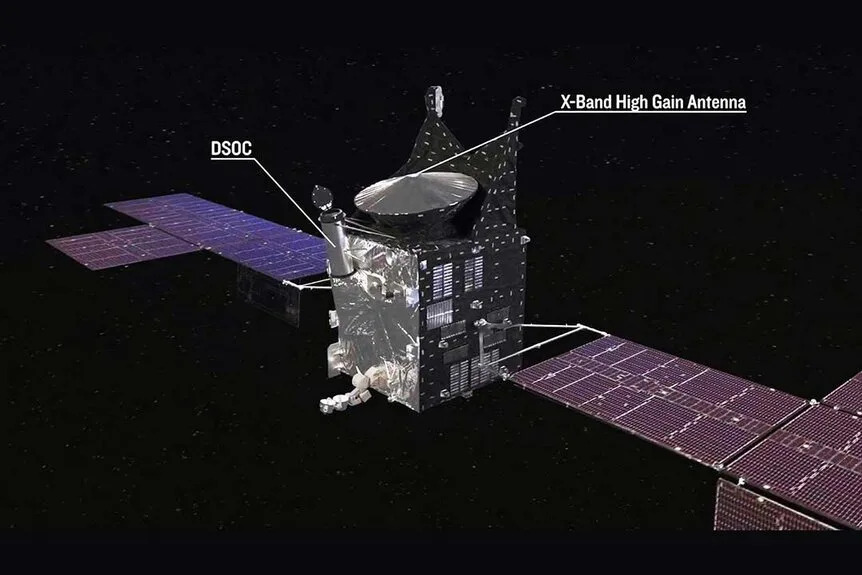
An illustration of the Psyche spacecraft
This illustration of the Psyche spacecraft shows the locations of the DSOC technology demonstration and X-band high-gain antenna Photo: NASA/JPL-Caltech/ASUImage: Ground telescopes
Of course, we’ve sent and received signals from much farther distances before and we’re still doing it all the time. We have spacecraft happily whizzing around Jupiter and sending back information, not to mention the Voyager spacecraft, still eking out a living in interstellar space. But optical communication would offer significantly higher bandwidth. The goal is to build space-based communications systems with between 10 and 100 times the bandwidth of conventional radio-based communication. That’s because near-infrared lasers have tighter waves than radio, allowing more information to travel in a smaller package.
While the mission is still in its early stages, the team behind it recently achieved a milestone when they gathered first light from the experiment on November 14. From a distance of about 10 million miles (16 million kilometers), about ten times the distance to the Moon, DSOC locked onto an uplink laser beacon transmitting from JPL’s Optical Communications Telescope Laboratory near Wrightwood, California. Using that beacon, the DSOC adjusted its angle to point back at the Hale Telescope at the Palomar Observatory in California. The successful back and forth between Earth and the DSOC marks the most distant demonstration of optical communication in history.
The Future of Laser Communication in Space
“Achieving first light is one of many critical DSOC milestones in the coming months, paving the way toward higher-data-rate communications capable of sending scientific information, high-definition imagery, and streaming video in support of humanity’s next giant leap: sending humans to Mars,” said Trudy Kortes, director of Technology Demonstrations at NASA Headquarters in Washington, in a statement.

The Hale Telescope at Caltech’s Palomar Observatory in San Diego County.
The 200-inch (5.1-meter) Hale Telescope at Caltech’s Palomar Observatory in San Diego County will receive high-rate data from the DSOC flight laser transceiver and (inset) the ground-based laser transmitter at JPL’s Table Mountain will send low-rate data to the flight transceiver. Photo: NASA/JPL-Caltech/Palomar Observatory
The instrument works by sending bits of data encoded in individual photons of laser light. Once those photons are received at the Hale Telescope, the data can be extracted from the photons and transformed back into ones and zeroes. As the Psyche spacecraft and the DSOC experiment travel farther away, scientists are working to refine the systems and control pointing the downlink laser. The farther it is, the more difficult it is to hit the receiving telescope with the laser beam, but it’s even more complicated than that.
RELATED: Everything You Need to Know About NASA's "Asteroid Autumn"
The technology also needs to take time and motion into account. When it gets to its final destination in the asteroid belt, the light travel time will be about 20 minutes, that’s plenty of time for both the spacecraft and the Earth to have moved. Any light beams being sent between the two will need to compensate for that movement. The DSOC needs to point not to where the receiving telescope is, but to where it will be.
A transition to optical systems should lead to a revolution in space-based communication and it might be just about as good as we can do, at least until we find a wormhole and crack FTL communication.
In the meantime, you can watch Farscape streaming now on Peacock. No lightspeed lag.
Earth received a message sent from a deep space laser — it took just 50 seconds to travel 10 million miles
Marianne Guenot
Wed, November 22, 2023

NASA beamed a message from nearly 10 million miles
The technological feat, using NASA's Psyche probe, broke new ground for deep space communications.
NASA hopes to one day send high-speed streaming to Mars.
NASA has achieved a world-first after sending a laser-beamed message to Earth from nearly 10 million miles away within 50 seconds.
While the space agency has long been able to communicate with spacecraft using radio waves, it had never before been able to send information using lasers from that far into space.
The feat, achieved using NASA's Deep Space Optical Communications (DSOC) experiment on board the Psyche spacecraft, could someday allow humans to stream video calls on Mars.
The system is capable of beaming information 10 to 100 times faster than current space communications equipment, per a press release published Thursday.

An artist's illustration shows an astronaut streaming from Mars.NASA/Lacey Young
Bringing fiber optic tech to Mars
The probe homed into a powerful laser signal sent from the Jet Propulsion Lab's (JPL's) Table Mountain Facility near Wrightwood, California. This acted like a beacon to help Psyche aim its transmitter.
The spacecraft then beamed back information using its laser. The signals were received by the Hale Telescope in San Diego County, California, within around 50 seconds.
The probe was about 10 million miles away at the time (16 million kilometers). That's about 40 times the distance from the Earth to the moon.

An artist's concept of the spacecraft of NASA's Psyche mission.NASA/JPL-Caltech/Arizona State Univ./Space Systems Loral/Peter Rubin
"Achieving first light is a tremendous achievement. The ground systems successfully detected the deep space laser photons from DSOC's flight transceiver aboard Psyche," said Abi Biswas, project technologist for DSOC at NASA's Jet Propulsion Laboratory.
"And we were also able to send some data, meaning we were able to exchange 'bits of light' from and to deep space.".
While getting a few bits from space may seem underwhelming, it is a crucial step that could revolutionize deep-space communications.
NASA and other space agencies are vying to bring humans back to the moon within the coming decade, a step toward their grander ambition to colonize Mars.
These explorers will need to be able to communicate with Earth effectively, and DSOC could help with that.
Optical communication is the same technology used in fiber optic internet. The light signal arrives just as fast as radio waves but can communicate a lot more information. This could offer high-bandwidth uploads and downloads.
"The primary objective is to give future NASA missions the tools for returning data at much higher rates," Biswas said in a video.

A diagram shows how much more quickly DSOC can theoretically download information from Mars and radio telecommunication systems.NASA/JPL-Caltech/ASU, Produced by: True Story Films
This first experiment is "paving the way toward higher-data-rate communications capable of sending scientific information, high-definition imagery, and streaming video in support of humanity's next giant leap: sending humans to Mars," said Trudy Kortes, NASA director of Technology Demonstrations for the Space Technology Mission Directorate.
The system required some high-tech engineering, including developing a cryogenically-cooled superconducting detector that could spot a billion photons per second to squeeze every bit of information from the faint light traveling tens of millions of miles to Earth.
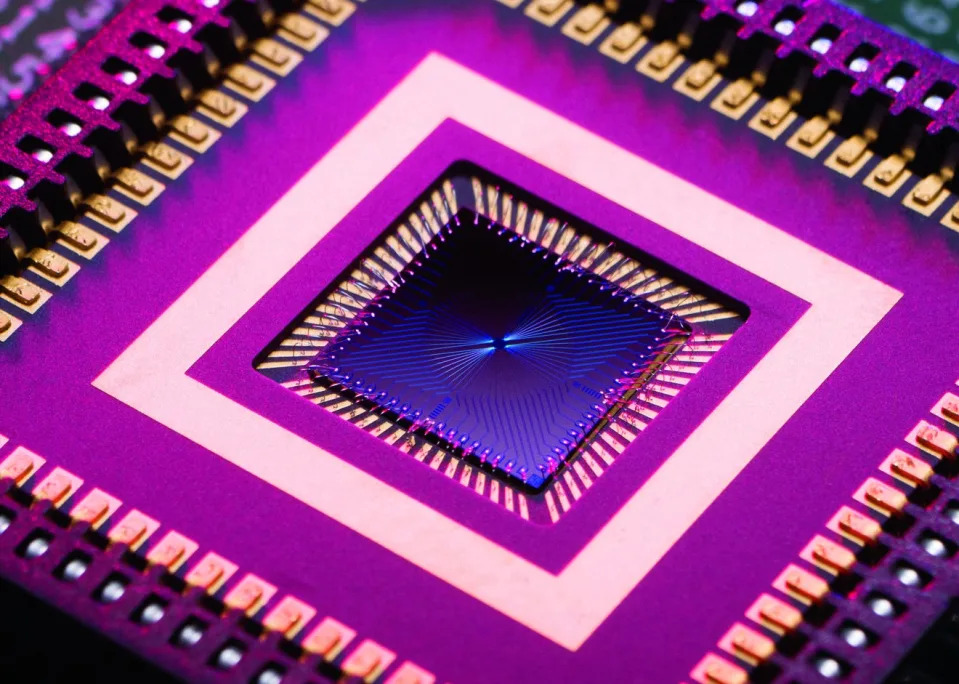
A close-up of the detector attached to DSOC's receiving ground station at Palomar.NASA/JPL-Caltech
While the experiment proved the system could work, the team has many challenges ahead.
The technology is designed to work when Mars is as far away from the Earth as possible — that's about 235 million miles, or more than twice the distance between the sun and Earth.
At that distance, the light sent by Psyche will be much fainter. And at that distance, the photons will take about 20 minutes to arrive.
That's enough time for both the spacecraft and Earth to have moved, which means JPL scientists will need to make some careful calibrations to make sure the signal is detected as it arrives.
The team aims to test Psyche's DSOC system again as it whizzes past Mars on its way to its mission target: the asteroid belt between the red planet and Jupiter.
NASA's Psyche spacecraft just fired a laser 10 million miles away in deep space
Rahul Rao
Tue, November 21, 2023
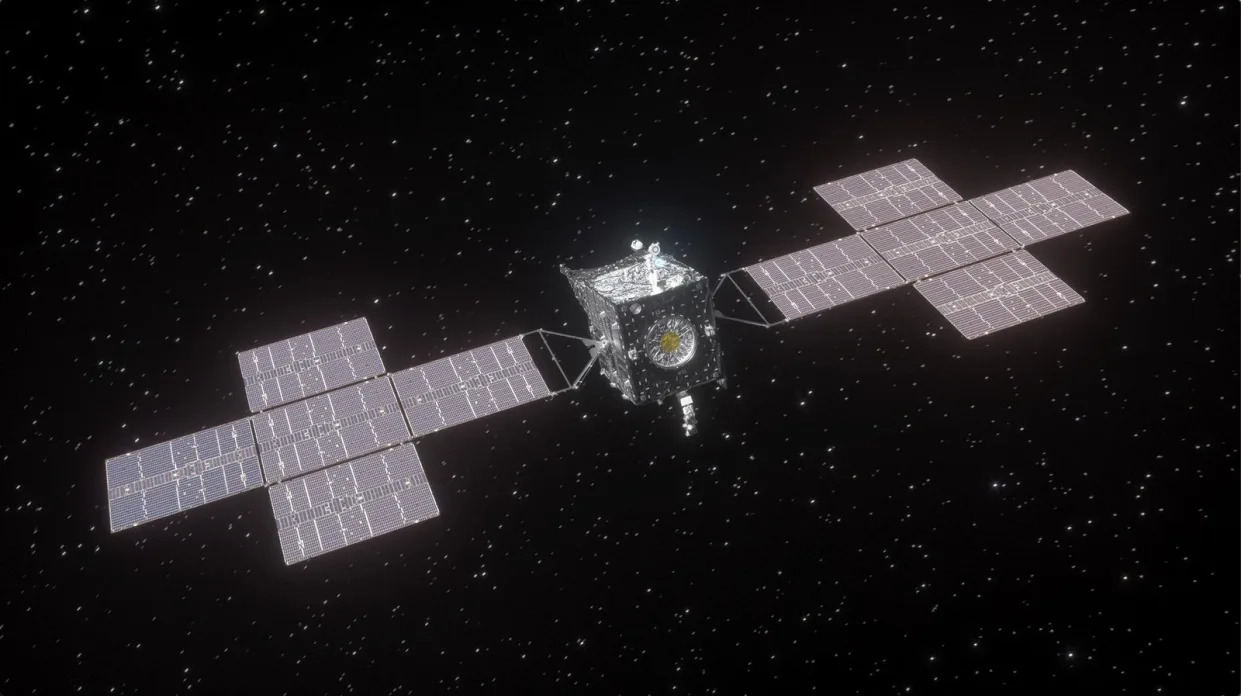
Illustration of spacecraft with two solar panels with stars and black space in behind.
A NASA laser just fired successfully in a deep-space test.
On Nov. 14, NASA picked up a laser signal fired from an instrument that launched with the Psyche spacecraft, which is currently more than 10 million miles (16 million kilometers) from Earth and heading toward a mysterious metal asteroid. (The spacecraft is at more than 40 times the average distance of Earth's moon, and still voyaging afar.)
The moment marked the first successful test of NASA's Deep Space Optical Communications (DSOC) system, a next-generation comms link that sends information not by radio waves but instead by laser light. It's part of a series of tests NASA is doing to speed up communications in deep space, on different missions.
Related: NASA's Psyche asteroid mission will test next-gen laser communications in space
"Achieving first light is a tremendous achievement. The ground systems successfully detected the deep space laser photons from DSOC," Abi Biswas, the system's project technologist at NASA's Jet Propulsion Laboratory (JPL) in Southern California, said in an agency statement.
"And we were also able to send some data, meaning we were able to exchange 'bits of light' from and to deep space," Biswas added.
Other missions have tried out laser comms in Earth orbit or on the way to the moon and back, but DSOC gives laser communications its trickiest, most distant test yet. If it's successful, NASA officials expect that astronauts of the coming decades, bound for the moon or for Mars, may use laser light as their means of taking with ground control.
This DSOC test began in California, at JPL's Table Mountain Facility. There, in the hills outside Los Angeles, engineers switched on an uplink beacon, a near-infrared laser pointed in Psyche's direction. About 50 seconds later, a transceiver on Psyche received the laser and relayed its own laser signal back to Palomar Observatory, near San Diego.
RELATED STORIES:
— NASA's Psyche asteroid mission will test next-gen laser communications in space
— How NASA's new laser communications mission will work in space
— NASA's Psyche metal asteroid mission will have a big impact on astronomy. Here's how
The task requires astronomical precision, and automated guidance systems help aim Psyche's own laser. But should the test work out, the benefits are high: Because laser light has shorter wavelengths than radio waves, using optical light would allow space missions to send 10 to 100 times more information per unit time than they currently do.
The Nov. 14 test marked "first light" for DSOC, and engineers will continue to test the system as Psyche voyages to its namesake asteroid, which resides in the asteroid belt between Mars and Jupiter. Psyche should get there in 2029, then spend 29 months surveying the bizarre metallic worl
Object Crashes Into Jupiter, Explodes
Maggie Harrison
Wed, November 22, 2023
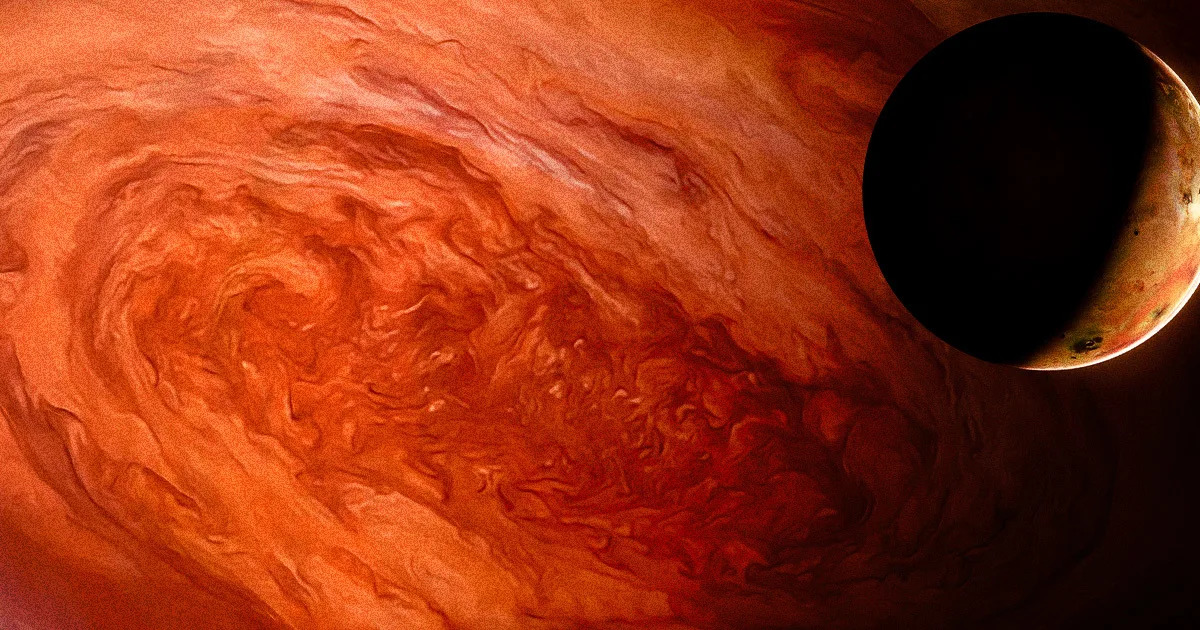
Flash in the Pan
See ya!
As Mashable reports, a video captured by an amateur astronomer in Japan shows a super-bright comet, also known as a bolide, exploding as it collides with Jupiter.
A gas giant, Jupiter has a powerful gravitational pull that's caused similar spectacular crashes over the years. This one wasn't even particularly powerful — unlike some previous Jupiterian impacts that humanity has been able to see, there doesn't seem to be any lingering visible damage to the planet's gaseous atmosphere — but it's fascinating to watch nonetheless. The scene has doomed-fly-to-lantern energy, albeit on a cosmic scale.
"There was another impact on Jupiter last night!" noted planetary astronomer Heidi Hammel, who works with NASA's James Webb Space Telescope, wrote in a Nov 16 quote tweet — if we can still call it that — of the original video. "The bright flash is a bolide — a shooting star in the atmosphere of Jupiter."
https://twitter.com/hbhammel/status/1725158567823475065?ref_src=twsrc%5Etfw%7Ctwcamp%5Etweetembed%7Ctwterm%5E1725158567823475065%7Ctwgr%5E36b329c4a7d5b483e872365432907ae020d0a5a1%7Ctwcon%5Es1_&ref_url=https%3A%2F%2Fmashable.com%2Farticle%2Fjupiter-asteroid-impact-footage
Incoming!
Bolides like the one seen in the video aren't unique to Jupiter; more commonly known as fireballs, a small handful of the ultra-bright celestial bodies enter Earth's atmosphere every year. They burn out quickly, and often make their way into Earth's atmosphere over expansive oceanic regions, and are therefore hard to catch from the ground.
While this fireball may not have done any real damage to Jupiter, other collisions certainly have. Back in 1994, the gas giant was pelted with pieces of the comet Shoemaker-Levy 9 over the course of several days, an event that according to NASA left "huge, dark scars in the planet's atmosphere and lofting superheated plumes into its stratosphere." And Hammel, who at the time "led visible-light observations of the comet" with NASA's Hubble Space Telescope, counts that impact as a turning point in Earth-asteroid relationships.
"Shoemaker-Levy 9 was a sort of punch in the gut," Hammel recounted of the impact back in 2019. "It really invigorated our understanding of how important it is to monitor our local neighborhood, and to understand what the potential is for impacts on Earth in the future.”
Bolides haven't presented a huge problem for planet Earth, and as NASA's successful DART test showed last year, humankind has made significant progress in our asteroid defense systems. But if this latest bolide is anything, it's a reminder that the final frontier is sometimes a game of brutal cosmic bumper cars.
More on planetary defense: NASA Pleased with the Degree to Which It Kicked This Asteroid's A**
Unexplained structures detected at heart of Milky Way in new James Webb Space Telescope image
Nicole Karlis
Tue, November 21, 2023

Image of the Sagittarius C (Sgr C) region NASA, ESA, CSA, STScI, and S. Crowe (University of Virginia)
A new photo from the James Webb Space Telescope of the deep center of the Milky Way highlights never-before-features that have yet to be scientifically explained. Specifically, JWST narrowed in on the region called Sagittarius C (Sgr C), which is about 300 light-years away from Sagittarius A*, the supermassive black hole at the Milky Way’s center. The unprecedented detail casts the region in a new light to astronomers, allowing them to study it in ways that weren't possible before.
Astronomers say the level of resolution is allowing them to see new features for the very first time, like how the galactic center is actually a very crowded place with around 500,000 stars — including a cluster of protostars, which are stars that are still forming. At the heart of this cluster is a previously known massive protostar that is 30 times the mass of our own Sun. JWST’s NIRCam (Near-Infrared Camera) instrument also captured large-scale emission from ionized hydrogen bordering the lower side of an infrared-dark cloud. Astronomers say they are excited to dig in, and hope this new image will lead to unprecedented information on how stars form.
“There’s never been any infrared data on this region with the level of resolution and sensitivity we get with Webb, so we are seeing lots of features here for the first time,” said the observation team’s principal investigator Samuel Crowe, in a media statement. “The image from Webb is stunning, and the science we will get from it is even better.”
Starship's 33 Engines Created The Mother Of All 'Shock Diamonds'
Oliver Parken
Mon, November 20, 2023
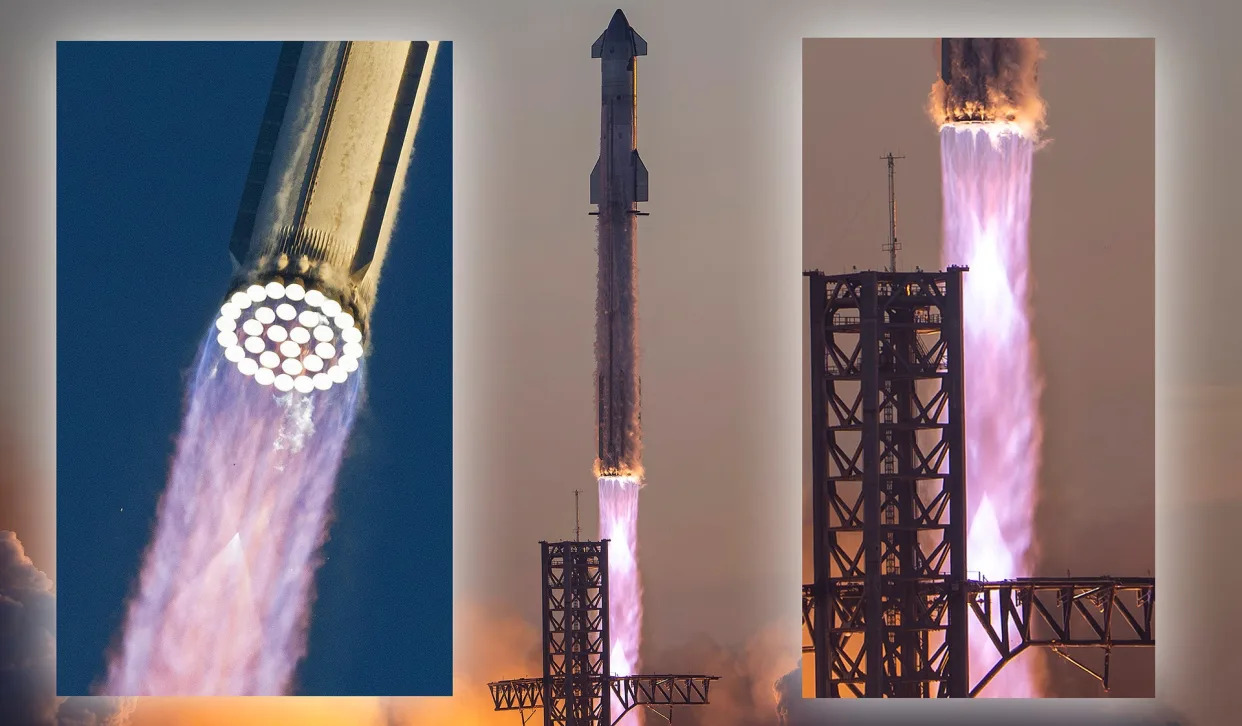
Shock diamonds from Starship's rocket exhaust
SpaceX’s massive Starship rocket lifted off for its second test flight over the weekend. Among the stunning imagery and video to have emerged from the launch that caught our attention was the sight of its super-heavy rocket booster generating gargantuan "mach diamonds" or "shock diamonds." What’s particularly impressive is how the rocket booster’s 33 Raptor engines combined to create a perfectly formed mach diamond as the stack lifted off the pad.
Given how incredible this example of physics visualized on a grand scale looks in the photos, we thought it was an opportune moment to dig deeper into the science behind them, as well as explain what makes their unique appearance during the recent Starship test launch so intriguing.
https://twitter.com/johnkrausphotos/status/1725863945276195266
The 'Starship' system, comprised of a super-heavy rocket booster and spacecraft, took off from SpaceX’s Starbase facility near Boca Chica Beach in South Texas on November 18. In a significant development for SpaceX, and in comparison to the first Starship test launch in April, the rocket booster was successfully able to separate from the spacecraft. This was before the rocket booster exploded over the Gulf of Mexico at an altitude of 91 miles (148 kilometers). Moreover, contact was lost with the spacecraft after it reached space, with the company having to trigger its self-destruct feature shortly thereafter. Eventually, Space X intends for its Starship system to carry crew and cargo to Earth orbit, the Moon, Mars and beyond.
https://www.youtube.com/watch?v=Iv5AMNYGql4
Tue, November 21, 2023

Illustration of spacecraft with two solar panels with stars and black space in behind.
A NASA laser just fired successfully in a deep-space test.
On Nov. 14, NASA picked up a laser signal fired from an instrument that launched with the Psyche spacecraft, which is currently more than 10 million miles (16 million kilometers) from Earth and heading toward a mysterious metal asteroid. (The spacecraft is at more than 40 times the average distance of Earth's moon, and still voyaging afar.)
The moment marked the first successful test of NASA's Deep Space Optical Communications (DSOC) system, a next-generation comms link that sends information not by radio waves but instead by laser light. It's part of a series of tests NASA is doing to speed up communications in deep space, on different missions.
Related: NASA's Psyche asteroid mission will test next-gen laser communications in space
"Achieving first light is a tremendous achievement. The ground systems successfully detected the deep space laser photons from DSOC," Abi Biswas, the system's project technologist at NASA's Jet Propulsion Laboratory (JPL) in Southern California, said in an agency statement.
"And we were also able to send some data, meaning we were able to exchange 'bits of light' from and to deep space," Biswas added.
Other missions have tried out laser comms in Earth orbit or on the way to the moon and back, but DSOC gives laser communications its trickiest, most distant test yet. If it's successful, NASA officials expect that astronauts of the coming decades, bound for the moon or for Mars, may use laser light as their means of taking with ground control.
This DSOC test began in California, at JPL's Table Mountain Facility. There, in the hills outside Los Angeles, engineers switched on an uplink beacon, a near-infrared laser pointed in Psyche's direction. About 50 seconds later, a transceiver on Psyche received the laser and relayed its own laser signal back to Palomar Observatory, near San Diego.
RELATED STORIES:
— NASA's Psyche asteroid mission will test next-gen laser communications in space
— How NASA's new laser communications mission will work in space
— NASA's Psyche metal asteroid mission will have a big impact on astronomy. Here's how
The task requires astronomical precision, and automated guidance systems help aim Psyche's own laser. But should the test work out, the benefits are high: Because laser light has shorter wavelengths than radio waves, using optical light would allow space missions to send 10 to 100 times more information per unit time than they currently do.
The Nov. 14 test marked "first light" for DSOC, and engineers will continue to test the system as Psyche voyages to its namesake asteroid, which resides in the asteroid belt between Mars and Jupiter. Psyche should get there in 2029, then spend 29 months surveying the bizarre metallic worl
Object Crashes Into Jupiter, Explodes
Maggie Harrison
Wed, November 22, 2023

Flash in the Pan
See ya!
As Mashable reports, a video captured by an amateur astronomer in Japan shows a super-bright comet, also known as a bolide, exploding as it collides with Jupiter.
A gas giant, Jupiter has a powerful gravitational pull that's caused similar spectacular crashes over the years. This one wasn't even particularly powerful — unlike some previous Jupiterian impacts that humanity has been able to see, there doesn't seem to be any lingering visible damage to the planet's gaseous atmosphere — but it's fascinating to watch nonetheless. The scene has doomed-fly-to-lantern energy, albeit on a cosmic scale.
"There was another impact on Jupiter last night!" noted planetary astronomer Heidi Hammel, who works with NASA's James Webb Space Telescope, wrote in a Nov 16 quote tweet — if we can still call it that — of the original video. "The bright flash is a bolide — a shooting star in the atmosphere of Jupiter."
https://twitter.com/hbhammel/status/1725158567823475065?ref_src=twsrc%5Etfw%7Ctwcamp%5Etweetembed%7Ctwterm%5E1725158567823475065%7Ctwgr%5E36b329c4a7d5b483e872365432907ae020d0a5a1%7Ctwcon%5Es1_&ref_url=https%3A%2F%2Fmashable.com%2Farticle%2Fjupiter-asteroid-impact-footage
Incoming!
Bolides like the one seen in the video aren't unique to Jupiter; more commonly known as fireballs, a small handful of the ultra-bright celestial bodies enter Earth's atmosphere every year. They burn out quickly, and often make their way into Earth's atmosphere over expansive oceanic regions, and are therefore hard to catch from the ground.
While this fireball may not have done any real damage to Jupiter, other collisions certainly have. Back in 1994, the gas giant was pelted with pieces of the comet Shoemaker-Levy 9 over the course of several days, an event that according to NASA left "huge, dark scars in the planet's atmosphere and lofting superheated plumes into its stratosphere." And Hammel, who at the time "led visible-light observations of the comet" with NASA's Hubble Space Telescope, counts that impact as a turning point in Earth-asteroid relationships.
"Shoemaker-Levy 9 was a sort of punch in the gut," Hammel recounted of the impact back in 2019. "It really invigorated our understanding of how important it is to monitor our local neighborhood, and to understand what the potential is for impacts on Earth in the future.”
Bolides haven't presented a huge problem for planet Earth, and as NASA's successful DART test showed last year, humankind has made significant progress in our asteroid defense systems. But if this latest bolide is anything, it's a reminder that the final frontier is sometimes a game of brutal cosmic bumper cars.
More on planetary defense: NASA Pleased with the Degree to Which It Kicked This Asteroid's A**
Unexplained structures detected at heart of Milky Way in new James Webb Space Telescope image
Nicole Karlis
Tue, November 21, 2023

Image of the Sagittarius C (Sgr C) region NASA, ESA, CSA, STScI, and S. Crowe (University of Virginia)
A new photo from the James Webb Space Telescope of the deep center of the Milky Way highlights never-before-features that have yet to be scientifically explained. Specifically, JWST narrowed in on the region called Sagittarius C (Sgr C), which is about 300 light-years away from Sagittarius A*, the supermassive black hole at the Milky Way’s center. The unprecedented detail casts the region in a new light to astronomers, allowing them to study it in ways that weren't possible before.
Astronomers say the level of resolution is allowing them to see new features for the very first time, like how the galactic center is actually a very crowded place with around 500,000 stars — including a cluster of protostars, which are stars that are still forming. At the heart of this cluster is a previously known massive protostar that is 30 times the mass of our own Sun. JWST’s NIRCam (Near-Infrared Camera) instrument also captured large-scale emission from ionized hydrogen bordering the lower side of an infrared-dark cloud. Astronomers say they are excited to dig in, and hope this new image will lead to unprecedented information on how stars form.
“There’s never been any infrared data on this region with the level of resolution and sensitivity we get with Webb, so we are seeing lots of features here for the first time,” said the observation team’s principal investigator Samuel Crowe, in a media statement. “The image from Webb is stunning, and the science we will get from it is even better.”
SpaceX’s explosive test flight achieved key milestones. But there is still a long way to go
Jackie Wattles, CNN
Tue, November 21, 2023 at 2:36 PM MST·11 min read
Mere moments after SpaceX’s Starship system — the most powerful rocket ever built — was lost in a test flight Saturday, a somewhat complicated narrative around the vehicle began to emerge.
The company immediately described the flight as a huge step in the right direction.
“What we did today will provide invaluable data to continue rapidly developing Starship,” SpaceX said Saturday in a statement. “With a test like this, success comes from what we learn, and today’s test will help us improve Starship’s reliability as SpaceX seeks to make life multiplanetary.”
Yet the loss of another Super Heavy rocket booster and Starship spacecraft highlights just how far they have left to go in the development process, even as significant progress is made. It also raises questions about whether SpaceX can meet some key deadlines on the horizon.
Enabling humans to colonize the cosmos is the ultimate goal for this vehicle: SpaceX intends to use it to send people to the moon, Mars and beyond.
Crucially, the Starship spacecraft is also the vehicle that NASA selected to land US astronauts on the moon for the first time in five decades as part of its Artemis program. The space agency is racing against China to get the job done, vying to become the first to develop a permanent lunar outpost and set the precedent for deep-space settlements.
The first lunar mission that would make use of Starship — Artemis III — is slated for late 2025. In the aftermath of the first failed test flight in April, NASA officials expressed concern that the vehicle wouldn’t be ready in time.
But federal officials reacted favorably to Saturday’s test launch. NASA Administrator Bill Nelson offered SpaceX his congratulations and noted “test is an opportunity to learn — then fly again.”
And to be clear, Starship is still an essential part of NASA’s moon-landing plan. However, there are numerous daunting technological hurdles left to clear before those lunar ambitions becomes reality.

SpaceX's mega rocket Starship launches for a test flight from Starbase in Boca Chica, Texas, on Saturday, November 18, 2023. - Eric Gay/AP
What SpaceX has left to learn
Several key aspects of the second flight test went to plan: When the rocket took off from the SpaceX Starbase launch site in Boca Chica, Texas, just after 8 a.m. ET, it was able to ignite all 33 of its engines and continue firing them as the Super Heavy booster — which gives the initial burst of power at liftoff — burned through most of its fuel.
The Starship spacecraft was then able to ignite its own engines and break away from the Super Heavy rocket booster to continue the mission. And the launchpad that served as the starting point managed to survive the sheer force of a rocket generating up to 16.7 million pounds of thrust (7,590 tonnes of force).
None of those milestones were met during the vehicle’s inaugural integrated test flight in April.
But other important steps originally slated for Saturday’s mission didn’t happen. The Super Heavy booster experienced a “rapid unscheduled disassembly” — or an unintentional explosion — shortly after Starship separated from it. The mishap prevented SpaceX from testing the maneuvers that will be necessary to land and reuse the launch vehicle.
Similarly, the Starship capsule made it roughly 10 minutes into its flight, reaching an altitude considered to be beyond the edge of space — about 93 miles (150 kilometers) above Earth’s surface — but SpaceX was forced to terminate the mission when ground control lost its signal.
The vehicle did not spend as much time in space as the company had hoped, collecting mere moments of flight data rather than the hour-and-a-half’s worth mapped out for the mission. John Insprucker, principal integration engineer at SpaceX, said during the livestream that the company had to trigger Starship’s self-destruct feature after contact with the vehicle was lost.
That meant SpaceX wasn’t able to test out Starship’s landing technique either.
“The hardest part about this — or the part that will take the longest — is solving for safe (Starship) reentry and landing,” SpaceX CEO Elon Musk acknowledged in October during the International Astronautical Congress in Baku, Azerbaijian.
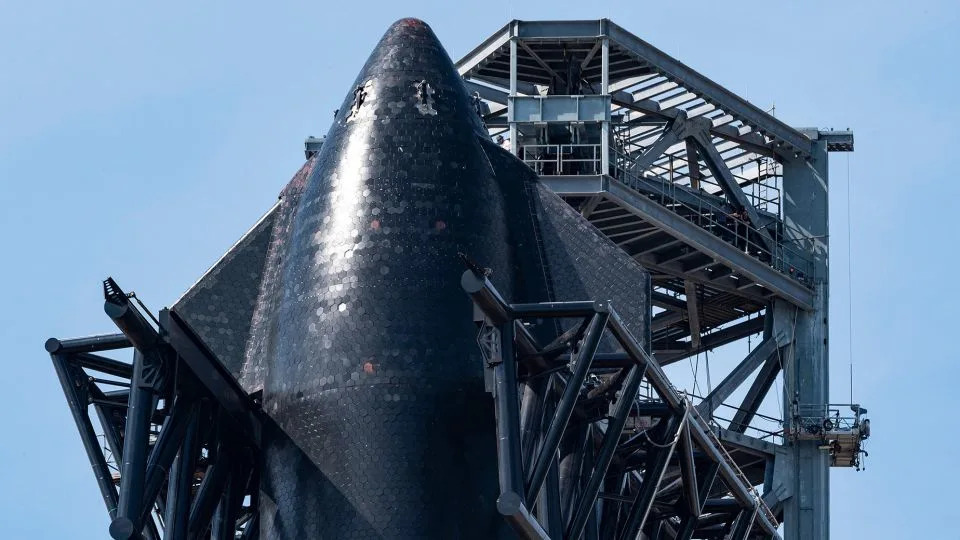
SpaceX's first orbital Starship SN20 is shown here stacked atop its massive Super Heavy Booster 4 at the company's Starbase facility near Boca Chica Village in South Texas on February 10, 2022. - Jim Watson/AFP/Getty Images
Starship and orbital refueling
Being able to recover and rapidly reuse both the Starship spacecraft and the Super Heavy booster are essential to SpaceX’s long-term goals. Such capabilities would make the rocket system affordable and nimble enough to rapidly conduct all the launches necessary to get the vehicle to the moon.
In order to reach lunar orbit, Starship must be refueled while it’s parked near Earth. That’s because the massive spacecraft won’t have enough propellant left over to traverse the 238,900-mile (384,472-kilometer) void between our home planet and the moon after the initial launch process.
As of now, SpaceX acknowledges it has to launch more than a dozen Starship tankers to refuel one spacecraft destined for the moon, said Wayne Hale — the chair of the NASA Advisory Council’s Human Exploration and Operations Committee — in a Saturday interview. That’s because of the Starship’s immense size: Just getting the vehicle into space requires it to burn through the majority of its fuel. And while Starship can hold up to 3 million (1,500 metric tons) of propellant, the spacecraft itself is only capable of hauling up to 55,000 pounds (250 metric tons) of extra cargo to orbit, according to data published by SpaceX and the FAA.
“So they’ve got to take that rocket that we saw demonstrated … and be able to fly 12, 15 more times for each lunar landing,” Hale told CNN. “That’s gonna be an impressive feat. They’ve got to learn how to do that … where it’s successful and reliable every time, and they’ve got to do that in a very short period of time.”
Starship and the Artemis timeline
With many milestones left to hit, it’s clear that even if the next Starship test flight is wholly successful, a moon landing will remain on the distant horizon.
Musk previously acknowledged in 2020 that he hopes SpaceX will launch “hundreds of missions” with satellites before attempting a flight with crew. SpaceX also must build and test the versions of Starship that will serve as refueling tankers. A lander must be outfitted with life support equipment. And NASA will require Starship to make an uncrewed test landing on the moon before allowing its astronauts on board.
Still, SpaceX emphasized that explosive failures can be integral to its development process, which embraces fiery mishaps in the early stages of designing a rocket in order to learn how to build a better rocket faster than if the company solely relied on ground tests.
Though SpaceX’s failed test flights garner plenty of critics, it does not mean that the company is moving more slowly or costing more money than if NASA had attempted to develop a lunar lander itself.
All told, NASA will pay SpaceX about $4 billion for two lunar landings. (The company has already invested more than $3 billion in developing its South Texas launch facility and the Starship Super Heavy launch system since 2014, according to an FAA court filing dated May 19.)
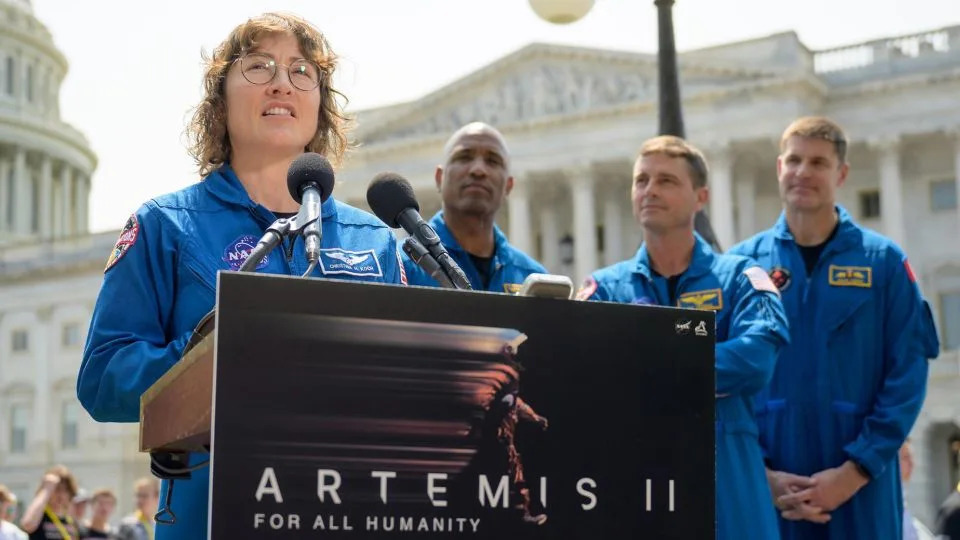
NASA Astronaut Christina Hammock Koch speaks during a Washington media gathering on May 18, 2023, as NASA astronauts Victor Glover and Reid Wiseman and CSA (Canadian Space Agency) astronaut Jeremy Hansen look on. Wiseman, Glover, Hammock Koch, and Hansen, are expected to fly around the moon on NASA's Artemis II flight test, slated for 2024. - Bill Ingalls/NASAMore
For comparison, the Space Launch System rocket and Orion spacecraft that NASA developed for the Artemis program have together cost more than $44 billion since 2006, according to data aggregated by the nonprofit Planetary Society. That rocket system had its first flight test last year. Under NASA’s current plans, SLS and Orion would transport astronauts from Earth to lunar orbit, while Starship would complete the final leg of the journey, ferrying them from the Orion spacecraft to the moon’s surface.
But Hale noted that SpaceX doesn’t use the same development approach as NASA. The space agency spends years on careful design and rigorous ground testing — all but guaranteeing success on the first flight. In contrast, SpaceX wants to put early prototypes in the air, accepting that they may explode but will likely provide valuable information for future testing.
“This is a different paradigm,” Hale said of Starship development. “The government — when you’re working with the taxpayers’ dollars — you really want to be careful and make sure you succeed.
“Whereas (SpaceX) is a private company,” Hale added. “Yes, they’re doing this work in support of the government, but their methodology is quite different. And I think you could be successful either way. But, this way certainly has its exciting moments.”
Another lunar lander: Starship vs. Blue Moon
Starship can also be compared with Blue Moon, another lunar lander under development by the Jeff Bezos-owned space company Blue Origin. NASA selected Blue Moon as an alternative lunar lander for future Artemis missions.
NASA expects to pay the company $3.4 billion for a single crewed lunar landing — the Artemis V mission currently slated for 2028 — with Blue Origin investing at least that much of its own money.
Lakiesha Hawkins, the deputy to the deputy associate administrator for NASA’s moon to Mars program, said at its advisory council’s Human Exploration and Operations Committee meeting last week that Blue Origin’s lunar lander won’t necessarily be simpler than SpaceX’s behemoth rocket and spacecraft system.
“Both of those providers have their challenges,” Hawkins said, referring to SpaceX’s Starship and Blue Origin’s Blue Moon lunar lander. “And they are equally — from my perspective — complex.”
Blue Origin declined to comment on where Blue Moon stands in the development process.
The companies are taking very different approaches in their moon landing strategies, but experts say both SpaceX and Blue Origin will be distinct from their predecessor in some key ways.
Why NASA isn’t just repeating Apollo
Hale, the committee chair, said it can be difficult for members of the public to wrap their heads around why all of these projects are costing so much development time and money if NASA already knows how to put humans on the moon.
Why not just repeat the same thing NASA did during the Apollo program?
“People ask what was wrong with Apollo,” Hale said during the committee meeting last week. “The thing that was wrong with Apollo was it ended.”
NASA and SpaceX are aiming to develop vehicles that don’t just go to the moon once. Apollo already accomplished the “flags and footprints” missions, Hale noted.
Now, the space agency is looking to develop rockets and spacecraft that can push exploration further. NASA aims to establish a permanent moon base and eventually reach Mars in a cost-effective manner.

The Apollo 11 mission, the first manned lunar mission, launched from the Kennedy Space Center in Florida via the Saturn V launch vehicle on July 16, 1969 and safely returned to Earth on July 24, 1969. Aboard the spacecraft were astronauts Neil A. Armstrong, commander; Michael Collins, command module pilot; and Edwin E. Aldrin Jr., lunar module pilot. -
“When you put those sustainable reusability requirements on the program — and the fact that it’s leading on to go to Mars — you do buy into perhaps a more complicated architecture than just repeating Apollo,” Hale said.
And, even as he acknowledged Starship has a long way to go, he added, “I think they made a big step forward.”
What’s next for Starship
Musk has already said the Super Heavy booster and Starship spacecraft will likely be ready for a third test flight in “3 to 4 weeks,” according to a Sunday post on social media, adding, “There are three ships in final production.”
CNN noted that four Starship spacecraft and at least two Super Heavy boosters are visible from public roadways near SpaceX’s facility in South Texas.

SpaceX's Starship rocket prototypes are seen at the SpaceX Starbase in Brownsville, Texas, on August 19, 2023. - Veronica Cardenas/Reuters
It’s not clear, however, how long it will take SpaceX engineers to review the data gathered during Saturday’s flight and implement the necessary changes. And Musk is known to publicize unmet deadlines.
Also unclear is whether SpaceX will have the necessary regulatory approvals to launch another test flight in just a few weeks. The Federal Aviation Administration, which licenses commercial rocket launches, indicated its intentions to open a standard mishap investigation into Saturday’s test flight. After the first test flight in April, a similar investigation took over four months to complete.
Once the investigation is closed, the federal agency will then likely need to complete a safety review of SpaceX’s plans for a third launch before it will issue another permit. It’s not clear how long that process might take.
The FAA did not respond to a request for comment.
Jackie Wattles, CNN
Tue, November 21, 2023 at 2:36 PM MST·11 min read
Mere moments after SpaceX’s Starship system — the most powerful rocket ever built — was lost in a test flight Saturday, a somewhat complicated narrative around the vehicle began to emerge.
The company immediately described the flight as a huge step in the right direction.
“What we did today will provide invaluable data to continue rapidly developing Starship,” SpaceX said Saturday in a statement. “With a test like this, success comes from what we learn, and today’s test will help us improve Starship’s reliability as SpaceX seeks to make life multiplanetary.”
Yet the loss of another Super Heavy rocket booster and Starship spacecraft highlights just how far they have left to go in the development process, even as significant progress is made. It also raises questions about whether SpaceX can meet some key deadlines on the horizon.
Enabling humans to colonize the cosmos is the ultimate goal for this vehicle: SpaceX intends to use it to send people to the moon, Mars and beyond.
Crucially, the Starship spacecraft is also the vehicle that NASA selected to land US astronauts on the moon for the first time in five decades as part of its Artemis program. The space agency is racing against China to get the job done, vying to become the first to develop a permanent lunar outpost and set the precedent for deep-space settlements.
The first lunar mission that would make use of Starship — Artemis III — is slated for late 2025. In the aftermath of the first failed test flight in April, NASA officials expressed concern that the vehicle wouldn’t be ready in time.
But federal officials reacted favorably to Saturday’s test launch. NASA Administrator Bill Nelson offered SpaceX his congratulations and noted “test is an opportunity to learn — then fly again.”
And to be clear, Starship is still an essential part of NASA’s moon-landing plan. However, there are numerous daunting technological hurdles left to clear before those lunar ambitions becomes reality.

SpaceX's mega rocket Starship launches for a test flight from Starbase in Boca Chica, Texas, on Saturday, November 18, 2023. - Eric Gay/AP
What SpaceX has left to learn
Several key aspects of the second flight test went to plan: When the rocket took off from the SpaceX Starbase launch site in Boca Chica, Texas, just after 8 a.m. ET, it was able to ignite all 33 of its engines and continue firing them as the Super Heavy booster — which gives the initial burst of power at liftoff — burned through most of its fuel.
The Starship spacecraft was then able to ignite its own engines and break away from the Super Heavy rocket booster to continue the mission. And the launchpad that served as the starting point managed to survive the sheer force of a rocket generating up to 16.7 million pounds of thrust (7,590 tonnes of force).
None of those milestones were met during the vehicle’s inaugural integrated test flight in April.
But other important steps originally slated for Saturday’s mission didn’t happen. The Super Heavy booster experienced a “rapid unscheduled disassembly” — or an unintentional explosion — shortly after Starship separated from it. The mishap prevented SpaceX from testing the maneuvers that will be necessary to land and reuse the launch vehicle.
Similarly, the Starship capsule made it roughly 10 minutes into its flight, reaching an altitude considered to be beyond the edge of space — about 93 miles (150 kilometers) above Earth’s surface — but SpaceX was forced to terminate the mission when ground control lost its signal.
The vehicle did not spend as much time in space as the company had hoped, collecting mere moments of flight data rather than the hour-and-a-half’s worth mapped out for the mission. John Insprucker, principal integration engineer at SpaceX, said during the livestream that the company had to trigger Starship’s self-destruct feature after contact with the vehicle was lost.
That meant SpaceX wasn’t able to test out Starship’s landing technique either.
“The hardest part about this — or the part that will take the longest — is solving for safe (Starship) reentry and landing,” SpaceX CEO Elon Musk acknowledged in October during the International Astronautical Congress in Baku, Azerbaijian.

SpaceX's first orbital Starship SN20 is shown here stacked atop its massive Super Heavy Booster 4 at the company's Starbase facility near Boca Chica Village in South Texas on February 10, 2022. - Jim Watson/AFP/Getty Images
Starship and orbital refueling
Being able to recover and rapidly reuse both the Starship spacecraft and the Super Heavy booster are essential to SpaceX’s long-term goals. Such capabilities would make the rocket system affordable and nimble enough to rapidly conduct all the launches necessary to get the vehicle to the moon.
In order to reach lunar orbit, Starship must be refueled while it’s parked near Earth. That’s because the massive spacecraft won’t have enough propellant left over to traverse the 238,900-mile (384,472-kilometer) void between our home planet and the moon after the initial launch process.
As of now, SpaceX acknowledges it has to launch more than a dozen Starship tankers to refuel one spacecraft destined for the moon, said Wayne Hale — the chair of the NASA Advisory Council’s Human Exploration and Operations Committee — in a Saturday interview. That’s because of the Starship’s immense size: Just getting the vehicle into space requires it to burn through the majority of its fuel. And while Starship can hold up to 3 million (1,500 metric tons) of propellant, the spacecraft itself is only capable of hauling up to 55,000 pounds (250 metric tons) of extra cargo to orbit, according to data published by SpaceX and the FAA.
“So they’ve got to take that rocket that we saw demonstrated … and be able to fly 12, 15 more times for each lunar landing,” Hale told CNN. “That’s gonna be an impressive feat. They’ve got to learn how to do that … where it’s successful and reliable every time, and they’ve got to do that in a very short period of time.”
Starship and the Artemis timeline
With many milestones left to hit, it’s clear that even if the next Starship test flight is wholly successful, a moon landing will remain on the distant horizon.
Musk previously acknowledged in 2020 that he hopes SpaceX will launch “hundreds of missions” with satellites before attempting a flight with crew. SpaceX also must build and test the versions of Starship that will serve as refueling tankers. A lander must be outfitted with life support equipment. And NASA will require Starship to make an uncrewed test landing on the moon before allowing its astronauts on board.
Still, SpaceX emphasized that explosive failures can be integral to its development process, which embraces fiery mishaps in the early stages of designing a rocket in order to learn how to build a better rocket faster than if the company solely relied on ground tests.
Though SpaceX’s failed test flights garner plenty of critics, it does not mean that the company is moving more slowly or costing more money than if NASA had attempted to develop a lunar lander itself.
All told, NASA will pay SpaceX about $4 billion for two lunar landings. (The company has already invested more than $3 billion in developing its South Texas launch facility and the Starship Super Heavy launch system since 2014, according to an FAA court filing dated May 19.)

NASA Astronaut Christina Hammock Koch speaks during a Washington media gathering on May 18, 2023, as NASA astronauts Victor Glover and Reid Wiseman and CSA (Canadian Space Agency) astronaut Jeremy Hansen look on. Wiseman, Glover, Hammock Koch, and Hansen, are expected to fly around the moon on NASA's Artemis II flight test, slated for 2024. - Bill Ingalls/NASAMore
For comparison, the Space Launch System rocket and Orion spacecraft that NASA developed for the Artemis program have together cost more than $44 billion since 2006, according to data aggregated by the nonprofit Planetary Society. That rocket system had its first flight test last year. Under NASA’s current plans, SLS and Orion would transport astronauts from Earth to lunar orbit, while Starship would complete the final leg of the journey, ferrying them from the Orion spacecraft to the moon’s surface.
But Hale noted that SpaceX doesn’t use the same development approach as NASA. The space agency spends years on careful design and rigorous ground testing — all but guaranteeing success on the first flight. In contrast, SpaceX wants to put early prototypes in the air, accepting that they may explode but will likely provide valuable information for future testing.
“This is a different paradigm,” Hale said of Starship development. “The government — when you’re working with the taxpayers’ dollars — you really want to be careful and make sure you succeed.
“Whereas (SpaceX) is a private company,” Hale added. “Yes, they’re doing this work in support of the government, but their methodology is quite different. And I think you could be successful either way. But, this way certainly has its exciting moments.”
Another lunar lander: Starship vs. Blue Moon
Starship can also be compared with Blue Moon, another lunar lander under development by the Jeff Bezos-owned space company Blue Origin. NASA selected Blue Moon as an alternative lunar lander for future Artemis missions.
NASA expects to pay the company $3.4 billion for a single crewed lunar landing — the Artemis V mission currently slated for 2028 — with Blue Origin investing at least that much of its own money.
Lakiesha Hawkins, the deputy to the deputy associate administrator for NASA’s moon to Mars program, said at its advisory council’s Human Exploration and Operations Committee meeting last week that Blue Origin’s lunar lander won’t necessarily be simpler than SpaceX’s behemoth rocket and spacecraft system.
“Both of those providers have their challenges,” Hawkins said, referring to SpaceX’s Starship and Blue Origin’s Blue Moon lunar lander. “And they are equally — from my perspective — complex.”
Blue Origin declined to comment on where Blue Moon stands in the development process.
The companies are taking very different approaches in their moon landing strategies, but experts say both SpaceX and Blue Origin will be distinct from their predecessor in some key ways.
Why NASA isn’t just repeating Apollo
Hale, the committee chair, said it can be difficult for members of the public to wrap their heads around why all of these projects are costing so much development time and money if NASA already knows how to put humans on the moon.
Why not just repeat the same thing NASA did during the Apollo program?
“People ask what was wrong with Apollo,” Hale said during the committee meeting last week. “The thing that was wrong with Apollo was it ended.”
NASA and SpaceX are aiming to develop vehicles that don’t just go to the moon once. Apollo already accomplished the “flags and footprints” missions, Hale noted.
Now, the space agency is looking to develop rockets and spacecraft that can push exploration further. NASA aims to establish a permanent moon base and eventually reach Mars in a cost-effective manner.

The Apollo 11 mission, the first manned lunar mission, launched from the Kennedy Space Center in Florida via the Saturn V launch vehicle on July 16, 1969 and safely returned to Earth on July 24, 1969. Aboard the spacecraft were astronauts Neil A. Armstrong, commander; Michael Collins, command module pilot; and Edwin E. Aldrin Jr., lunar module pilot. -
“When you put those sustainable reusability requirements on the program — and the fact that it’s leading on to go to Mars — you do buy into perhaps a more complicated architecture than just repeating Apollo,” Hale said.
And, even as he acknowledged Starship has a long way to go, he added, “I think they made a big step forward.”
What’s next for Starship
Musk has already said the Super Heavy booster and Starship spacecraft will likely be ready for a third test flight in “3 to 4 weeks,” according to a Sunday post on social media, adding, “There are three ships in final production.”
CNN noted that four Starship spacecraft and at least two Super Heavy boosters are visible from public roadways near SpaceX’s facility in South Texas.

SpaceX's Starship rocket prototypes are seen at the SpaceX Starbase in Brownsville, Texas, on August 19, 2023. - Veronica Cardenas/Reuters
It’s not clear, however, how long it will take SpaceX engineers to review the data gathered during Saturday’s flight and implement the necessary changes. And Musk is known to publicize unmet deadlines.
Also unclear is whether SpaceX will have the necessary regulatory approvals to launch another test flight in just a few weeks. The Federal Aviation Administration, which licenses commercial rocket launches, indicated its intentions to open a standard mishap investigation into Saturday’s test flight. After the first test flight in April, a similar investigation took over four months to complete.
Once the investigation is closed, the federal agency will then likely need to complete a safety review of SpaceX’s plans for a third launch before it will issue another permit. It’s not clear how long that process might take.
The FAA did not respond to a request for comment.
Oliver Parken
Mon, November 20, 2023

Shock diamonds from Starship's rocket exhaust
SpaceX’s massive Starship rocket lifted off for its second test flight over the weekend. Among the stunning imagery and video to have emerged from the launch that caught our attention was the sight of its super-heavy rocket booster generating gargantuan "mach diamonds" or "shock diamonds." What’s particularly impressive is how the rocket booster’s 33 Raptor engines combined to create a perfectly formed mach diamond as the stack lifted off the pad.
Given how incredible this example of physics visualized on a grand scale looks in the photos, we thought it was an opportune moment to dig deeper into the science behind them, as well as explain what makes their unique appearance during the recent Starship test launch so intriguing.
https://twitter.com/johnkrausphotos/status/1725863945276195266
The 'Starship' system, comprised of a super-heavy rocket booster and spacecraft, took off from SpaceX’s Starbase facility near Boca Chica Beach in South Texas on November 18. In a significant development for SpaceX, and in comparison to the first Starship test launch in April, the rocket booster was successfully able to separate from the spacecraft. This was before the rocket booster exploded over the Gulf of Mexico at an altitude of 91 miles (148 kilometers). Moreover, contact was lost with the spacecraft after it reached space, with the company having to trigger its self-destruct feature shortly thereafter. Eventually, Space X intends for its Starship system to carry crew and cargo to Earth orbit, the Moon, Mars and beyond.
https://www.youtube.com/watch?v=Iv5AMNYGql4
https://twitter.com/SpaceX/status/1726314284488225050?s=20

SpaceX via X/Twitter
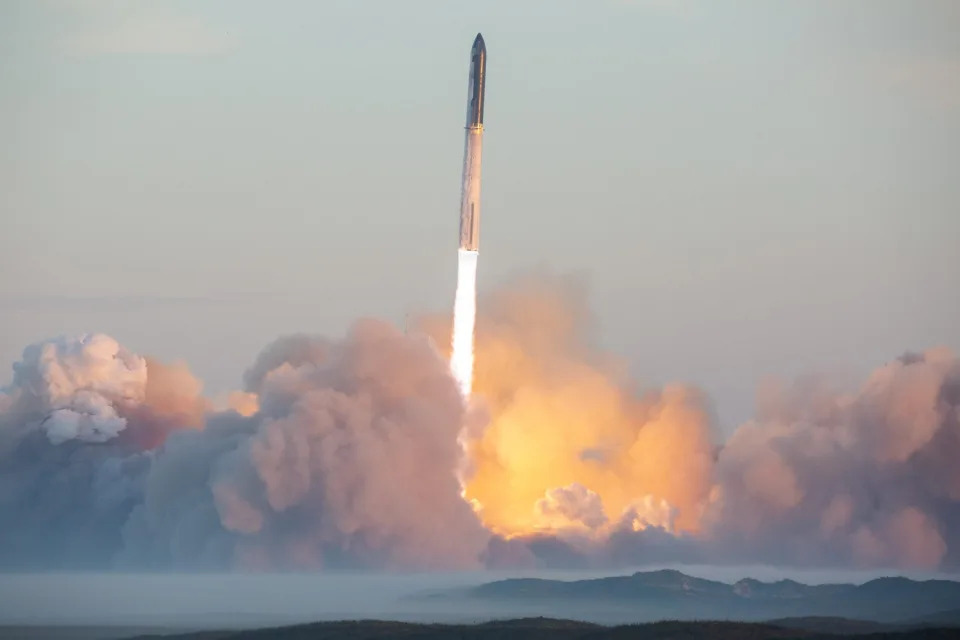
SpaceX via X/Twitter
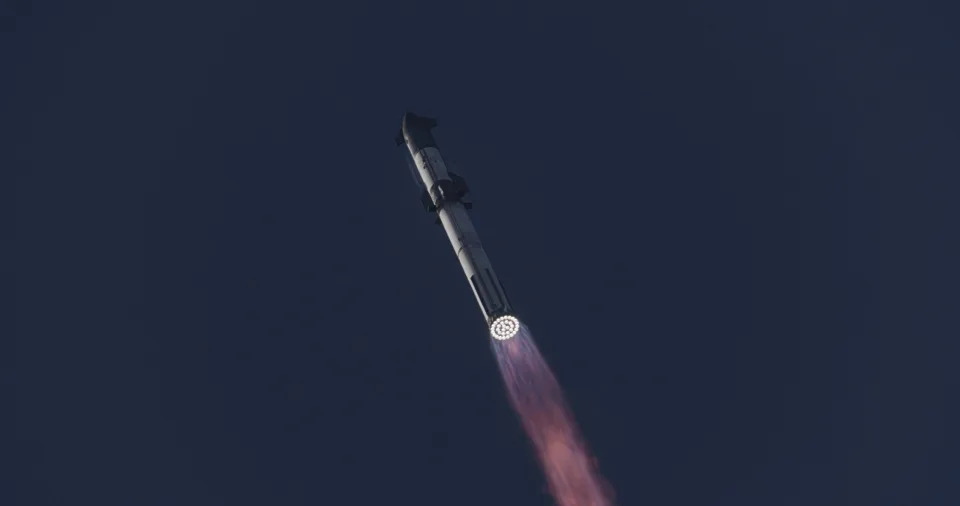
SpaceX via X/Twitter
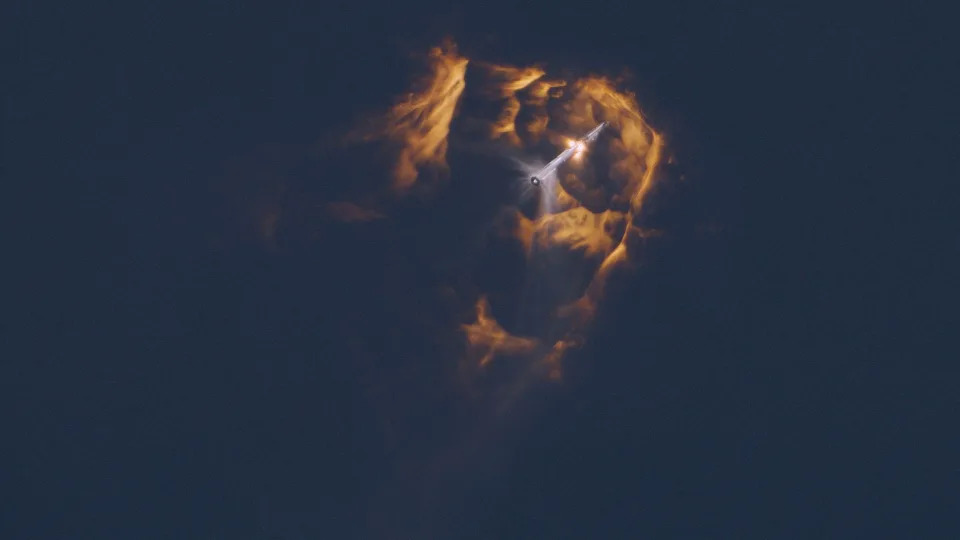
SpaceX via X/Twitter

SpaceX via X/Twitter

SpaceX via X/Twitter
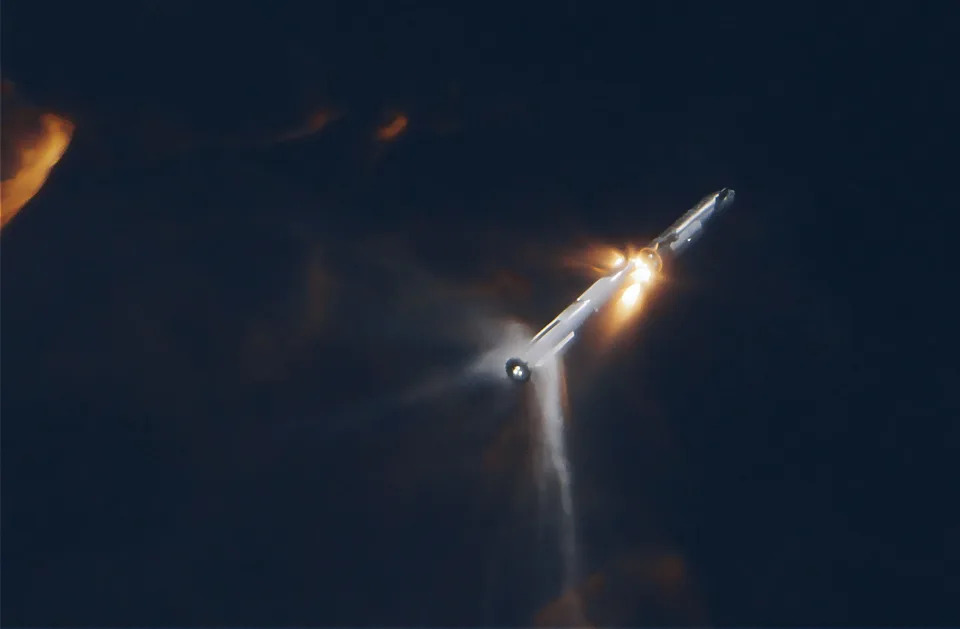
SpaceX via X/Twitter
While mach diamonds are more commonly seen when high-performance jets are in afterburner, Starships’ case is a unique as this phenomena was the culmination of 33 rocket engines firing in unison.

SR-71B seen during takeoff in 1992 with mach diamonds to its exhaust plume. NASA

F-16 in full afterburner, a string of shock diamonds emanating from its F100 turbofan. Tech. Sgt. Caycee Cook/USAF
Its super-heavy rocket booster's 33 engines includes 13 in the center and 20 surrounding the perimeter of the booster’s business end. Burning methane with liquid oxygen, the rocket booster is capable of creating a mind-boggling 16.7 million pounds of thrust.
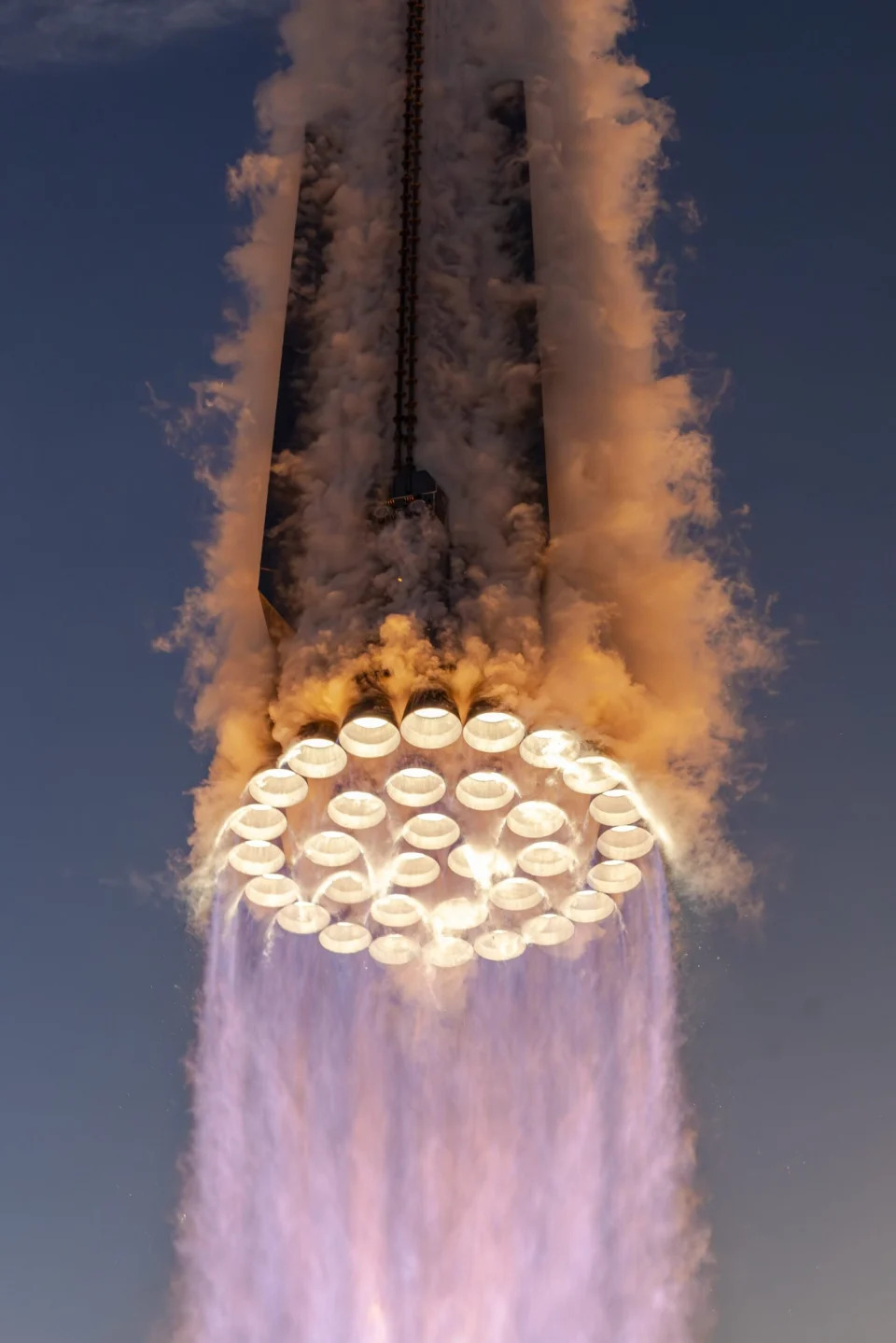
Starship rocket booster's 33 Raptor Vaccum engines. SpaceX via X/Twitter
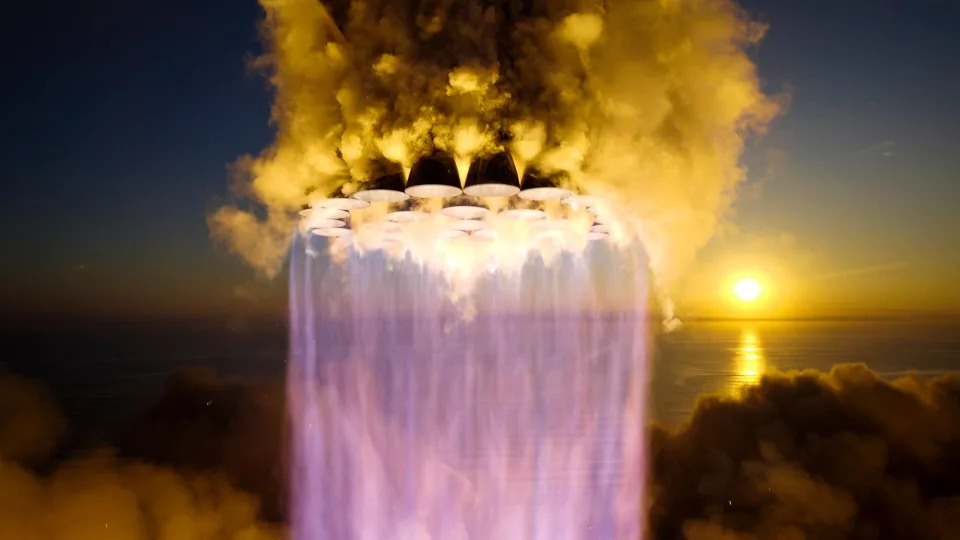
SpaceX via X/Twitter
In order to understand how the shock diamonds were produced during the Starship launch, we reached out to Dr. Chris Combs (@DrChrisCombs), the Dee Howard endowed assistant professor of aerodynamics at the University of Texas at San Antonio’s Department of Mechanical Engineering. Dr. Combs began by explaining how mach diamonds are formed in detail:
"Nature is always wanting to bring things back to equilibrium, in a sense, [to] kind of get things back to the way that they were in how they started," he said. "There are a lot of different processes in nature that work that way, and pressure differences is one of those."
"When you have something like a rocket, or a jet engine, that creates these really massive pressure differentials, relative to atmospheric air… physics is going to want to change that, and it's going to want to match those values up somehow. And if the pressure differentials are large enough, the only way that that can happen is with a shock wave or an expansion fan. And so these are compressible flow features, and waves that show up when basically you have a very large imbalance of pressure between two masses of air."
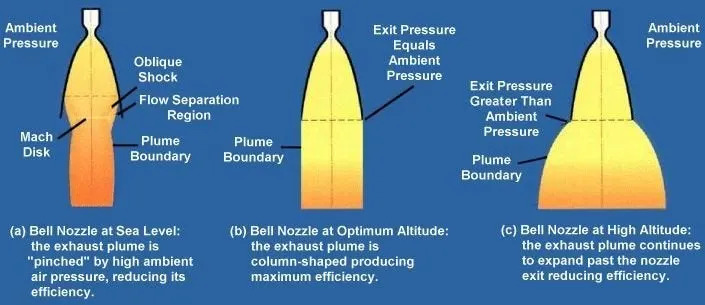
Schematic illustrating exhaust efficiency for rocket nozzles. Thomas van t Klooster
"At sea level, when you have a rocket launch, the exhaust that's coming out of the rocket is lower than atmospheric pressure… [resulting in] very high chamber pressures. But then you actually expand that gas through a converging divergent nozzle, to accelerate it to very high speed, because that gives you thrust. So you're trying to accelerate that exhaust as fast as you can. And when you do that, the energy that was there in terms of pressure, gets… transferred to velocity and momentum. And so you're getting that thrust out, but you're losing pressure in the process. So that gas comes out lower than atmospheric pressure, when it comes out of rocket exhausts. And it's low enough where… the only way that that can be matched to atmospheric pressure is with a shockwave, and so the air gets processed through the shockwave."
"The reason you see a diamond pattern," he indicated, "is because the angle of that shockwave is going to be determined, really just by [the] pressure ratio."
Combs went on to explain why Starships’ 33 Raptor engines were capable of forming single mach diamonds during the launch.
"When you typically see a shock diamond or a mach diamond, it can be from like a jet engine test, or a single rocket nozzle test. [When you] look at those up close… you see the same shock diamond effect on the smaller scale."
"But what was interesting, specifically about this case [the second Starship launch], is you had 33 engines firing together, which you would kind of intuitively think would make for a pretty messy environment. I think close up [this] is probably true, there's some complicated dynamics happening there."
https://twitter.com/DrChrisCombs/status/1726259282427974003?s=20
"[When] you zoom out far enough, and really, what it boils down to is they're [the 33 engines, are] acting like one engine. And so you have a region of low pressure caused by all of these engines working together. And that forms this larger mach diamond structure, sort of in the far field, as you zoom out. So you have all these little mini mach diamonds from each one of those engines that's generated… That is especially unique, because there aren't very many rockets… that tried to function with this many rocket nozzles pack that closely together… the closest comp[arison] being the Soviet N1."
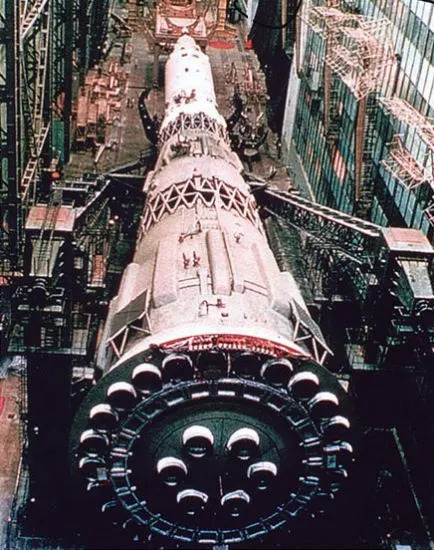
Soviet N1 Rocket showing the 30 rocket engines of its first stage. Unknown author
It should be noted that images taken from the launch also show additional diamonds forming a string, which can be seen below. "What you will notice, if you watch a rocket launch, as that rocket goes up in the air… [is] that angle is going to slowly change over time," Combs noted.
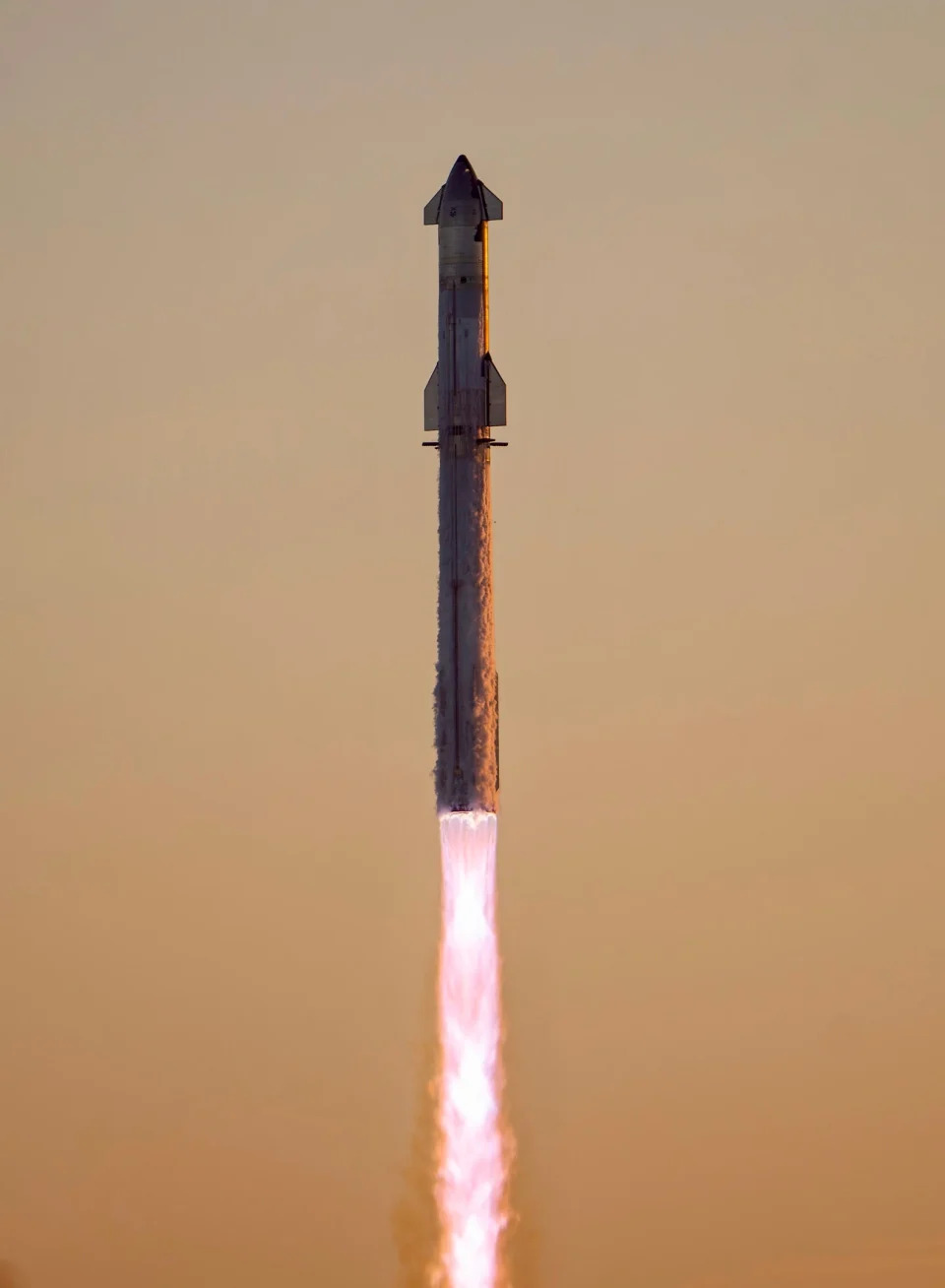
Multiple, individual mach diamonds seen during Starship's launch. SpaceX via X/Twitter
"And it's actually going to slowly go basically towards parallel with the rocket body. As the rocket goes up, that atmospheric pressure is going to drop because you're going higher up in altitude. And so that shock angle gets thinner as the rocket goes up until eventually the rocket exhaust is just going straight up and down, and you don't see any type of diamond effect. And that's… what we call a perfectly expanded exhaust. Because… the exhaust pressure is exactly what the ambient pressure is outside."
During our exchange, Combs also urged people to think of the recent test, which has been reported by some outlets as a failure, more holistically.
"I think people get frustrated sometimes when I say it's a long ways away," he noted of Starship. "But you have to understand… this is a relatively immature technology right now, that's going to take years to figure out versus [if] it's never going to work. I don't necessarily think it's never going to work. I think that there are some really big hurdles that those engineers have to overcome. And it's going to take time. So I think people need to kind of level expectations a little bit, but it's definitely an interesting project to follow that's extremely ambitious and high risk."
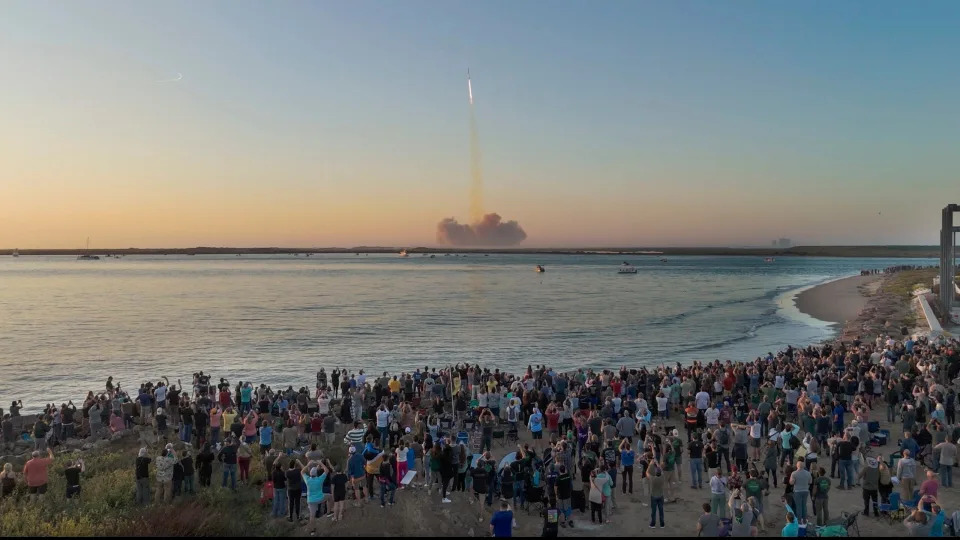
SpaceX via X/Twitter
So there you have it, an in-depth look at the gargantuan shock diamonds and why their merged appearance during Starship’s second test flight is so unique. A special thanks to Dr. Chris Combs for taking the time to provide us with such wonderful insight on this topic.
UPDATE: 11/21, 05:26 P.M. EST—
SpaceX has now released a slow-motion tracking shot of the super-heavy rocket booster's 33 engines forming huge mach diamonds during Starship's launch on November 18. Be sure to watch the footage below.
https://twitter.com/SpaceX/status/1727054554947268685?s=20
Contact the author: oliver@thewarzone.com
View comments (136)

SpaceX via X/Twitter

SpaceX via X/Twitter

SpaceX via X/Twitter

SpaceX via X/Twitter

SpaceX via X/Twitter

SpaceX via X/Twitter

SpaceX via X/Twitter
While mach diamonds are more commonly seen when high-performance jets are in afterburner, Starships’ case is a unique as this phenomena was the culmination of 33 rocket engines firing in unison.

SR-71B seen during takeoff in 1992 with mach diamonds to its exhaust plume. NASA

F-16 in full afterburner, a string of shock diamonds emanating from its F100 turbofan. Tech. Sgt. Caycee Cook/USAF
Its super-heavy rocket booster's 33 engines includes 13 in the center and 20 surrounding the perimeter of the booster’s business end. Burning methane with liquid oxygen, the rocket booster is capable of creating a mind-boggling 16.7 million pounds of thrust.

Starship rocket booster's 33 Raptor Vaccum engines. SpaceX via X/Twitter

SpaceX via X/Twitter
In order to understand how the shock diamonds were produced during the Starship launch, we reached out to Dr. Chris Combs (@DrChrisCombs), the Dee Howard endowed assistant professor of aerodynamics at the University of Texas at San Antonio’s Department of Mechanical Engineering. Dr. Combs began by explaining how mach diamonds are formed in detail:
"Nature is always wanting to bring things back to equilibrium, in a sense, [to] kind of get things back to the way that they were in how they started," he said. "There are a lot of different processes in nature that work that way, and pressure differences is one of those."
"When you have something like a rocket, or a jet engine, that creates these really massive pressure differentials, relative to atmospheric air… physics is going to want to change that, and it's going to want to match those values up somehow. And if the pressure differentials are large enough, the only way that that can happen is with a shock wave or an expansion fan. And so these are compressible flow features, and waves that show up when basically you have a very large imbalance of pressure between two masses of air."

Schematic illustrating exhaust efficiency for rocket nozzles. Thomas van t Klooster
"At sea level, when you have a rocket launch, the exhaust that's coming out of the rocket is lower than atmospheric pressure… [resulting in] very high chamber pressures. But then you actually expand that gas through a converging divergent nozzle, to accelerate it to very high speed, because that gives you thrust. So you're trying to accelerate that exhaust as fast as you can. And when you do that, the energy that was there in terms of pressure, gets… transferred to velocity and momentum. And so you're getting that thrust out, but you're losing pressure in the process. So that gas comes out lower than atmospheric pressure, when it comes out of rocket exhausts. And it's low enough where… the only way that that can be matched to atmospheric pressure is with a shockwave, and so the air gets processed through the shockwave."
"The reason you see a diamond pattern," he indicated, "is because the angle of that shockwave is going to be determined, really just by [the] pressure ratio."
Combs went on to explain why Starships’ 33 Raptor engines were capable of forming single mach diamonds during the launch.
"When you typically see a shock diamond or a mach diamond, it can be from like a jet engine test, or a single rocket nozzle test. [When you] look at those up close… you see the same shock diamond effect on the smaller scale."
"But what was interesting, specifically about this case [the second Starship launch], is you had 33 engines firing together, which you would kind of intuitively think would make for a pretty messy environment. I think close up [this] is probably true, there's some complicated dynamics happening there."
https://twitter.com/DrChrisCombs/status/1726259282427974003?s=20
"[When] you zoom out far enough, and really, what it boils down to is they're [the 33 engines, are] acting like one engine. And so you have a region of low pressure caused by all of these engines working together. And that forms this larger mach diamond structure, sort of in the far field, as you zoom out. So you have all these little mini mach diamonds from each one of those engines that's generated… That is especially unique, because there aren't very many rockets… that tried to function with this many rocket nozzles pack that closely together… the closest comp[arison] being the Soviet N1."

Soviet N1 Rocket showing the 30 rocket engines of its first stage. Unknown author
It should be noted that images taken from the launch also show additional diamonds forming a string, which can be seen below. "What you will notice, if you watch a rocket launch, as that rocket goes up in the air… [is] that angle is going to slowly change over time," Combs noted.

Multiple, individual mach diamonds seen during Starship's launch. SpaceX via X/Twitter
"And it's actually going to slowly go basically towards parallel with the rocket body. As the rocket goes up, that atmospheric pressure is going to drop because you're going higher up in altitude. And so that shock angle gets thinner as the rocket goes up until eventually the rocket exhaust is just going straight up and down, and you don't see any type of diamond effect. And that's… what we call a perfectly expanded exhaust. Because… the exhaust pressure is exactly what the ambient pressure is outside."
During our exchange, Combs also urged people to think of the recent test, which has been reported by some outlets as a failure, more holistically.
"I think people get frustrated sometimes when I say it's a long ways away," he noted of Starship. "But you have to understand… this is a relatively immature technology right now, that's going to take years to figure out versus [if] it's never going to work. I don't necessarily think it's never going to work. I think that there are some really big hurdles that those engineers have to overcome. And it's going to take time. So I think people need to kind of level expectations a little bit, but it's definitely an interesting project to follow that's extremely ambitious and high risk."

SpaceX via X/Twitter
So there you have it, an in-depth look at the gargantuan shock diamonds and why their merged appearance during Starship’s second test flight is so unique. A special thanks to Dr. Chris Combs for taking the time to provide us with such wonderful insight on this topic.
UPDATE: 11/21, 05:26 P.M. EST—
SpaceX has now released a slow-motion tracking shot of the super-heavy rocket booster's 33 engines forming huge mach diamonds during Starship's launch on November 18. Be sure to watch the footage below.
https://twitter.com/SpaceX/status/1727054554947268685?s=20
Contact the author: oliver@thewarzone.com
View comments (136)


